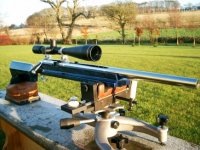If you think of how small the contact point is when 2 perfectly round balls collide then you will realize that this statement is probaly true. All shots must be hit perfect in order to make the shot. place 2 balls together and you will see how small the contact point is. No matter how you place them together the contact point size is the same whether you are straight in or cutting the ball at an angle. I had this discussion with a very very good pool player once in Charlotte, NC at Paradise billiards. I wish I could remember his name???? He taught me alot about the realistic side of aiming and contact..
What makes the straight in is its more dependent on tip placment than other shots. If you don't have a pure stroke and you try to hit center even if your aligned right...but hit to the left or right then the OB will throw off line and you miss. When you use english your already aiming off the side of the ball so if you miss the desired contact point on the CB by a small portion its not going to affect the line of your shot like it does when trying to hit center long and straight in... you miss center by a pinch and you just missed.
Its the same reason many players (matlock for example) use some english on bank shots if your hitting some right english then your going to hit right english basically every time. If you must hit pure center then the chances of you hitting left or right of it are greater and will result in a miss, which makes it a lower percentage shot. Its just a technique that adds another level of consistency.
Its mechanically less forgiving. Thats why its such a good item to use in your pratice regimine. I like shooting it and scratching the CB in the same pocket i make the OB in. I would have to overpower it too much to get it to draw back and scratch from corner to corner, but I can definately put a descent speed on the CB and shoot it straight and follow it without having to try to force anything.
Works well for me too, its one of my bread and butter shots to get me on my game quick if I need to do some preflight checks b/f i take off. It'll help you to diagnose stroke and mechanical problems really easy.
-Grey Ghost
Last edited:
